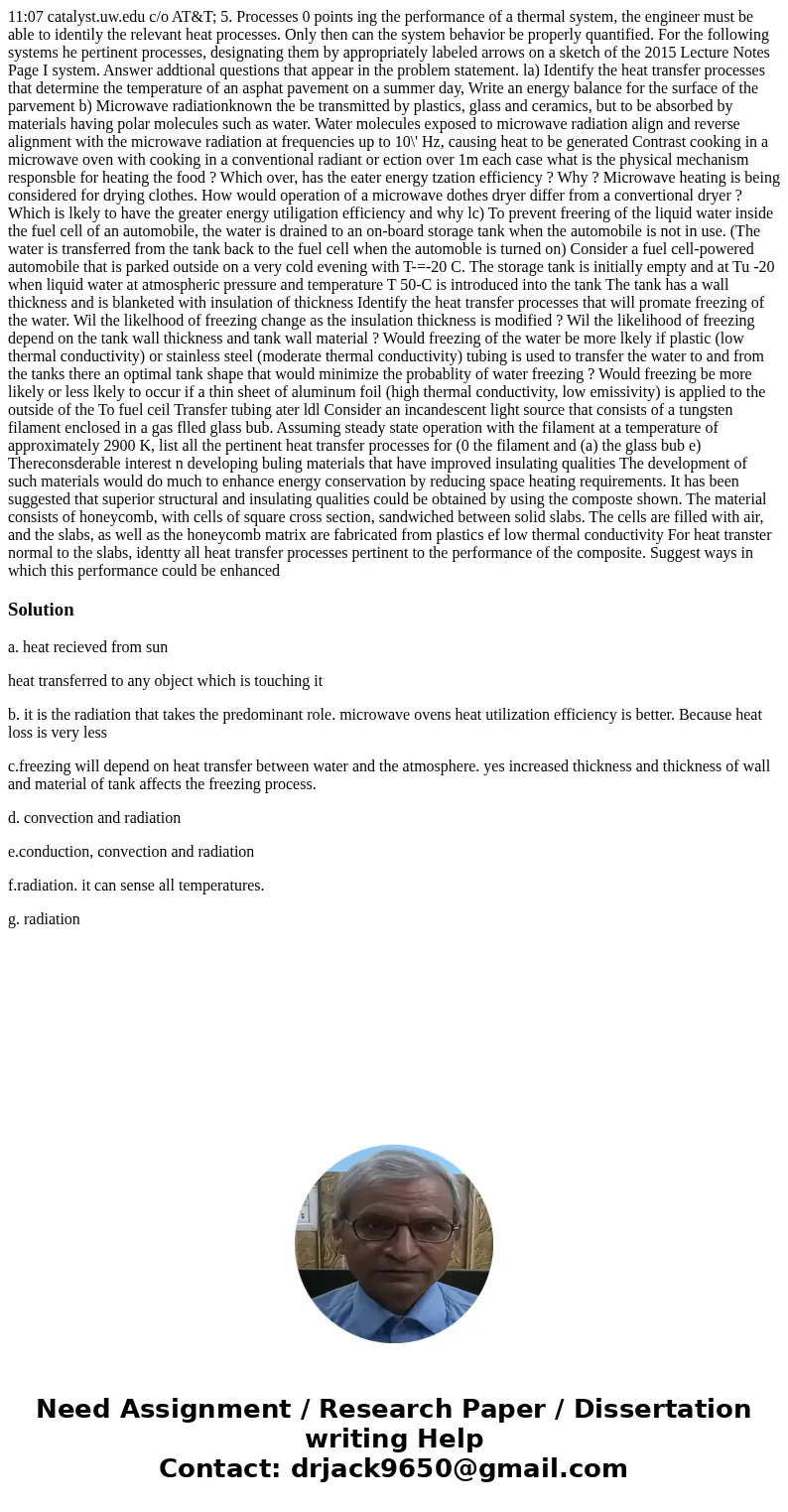1107 catalystuwedu co ATT 5 Processes 0 points ing the perfo
11:07 catalyst.uw.edu c/o AT&T; 5. Processes 0 points ing the performance of a thermal system, the engineer must be able to identily the relevant heat processes. Only then can the system behavior be properly quantified. For the following systems he pertinent processes, designating them by appropriately labeled arrows on a sketch of the 2015 Lecture Notes Page I system. Answer addtional questions that appear in the problem statement. la) Identify the heat transfer processes that determine the temperature of an asphat pavement on a summer day, Write an energy balance for the surface of the parvement b) Microwave radiationknown the be transmitted by plastics, glass and ceramics, but to be absorbed by materials having polar molecules such as water. Water molecules exposed to microwave radiation align and reverse alignment with the microwave radiation at frequencies up to 10\' Hz, causing heat to be generated Contrast cooking in a microwave oven with cooking in a conventional radiant or ection over 1m each case what is the physical mechanism responsble for heating the food ? Which over, has the eater energy tzation efficiency ? Why ? Microwave heating is being considered for drying clothes. How would operation of a microwave dothes dryer differ from a convertional dryer ? Which is lkely to have the greater energy utiligation efficiency and why lc) To prevent freering of the liquid water inside the fuel cell of an automobile, the water is drained to an on-board storage tank when the automobile is not in use. (The water is transferred from the tank back to the fuel cell when the automoble is turned on) Consider a fuel cell-powered automobile that is parked outside on a very cold evening with T-=-20 C. The storage tank is initially empty and at Tu -20 when liquid water at atmospheric pressure and temperature T 50-C is introduced into the tank The tank has a wall thickness and is blanketed with insulation of thickness Identify the heat transfer processes that will promate freezing of the water. Wil the likelhood of freezing change as the insulation thickness is modified ? Wil the likelihood of freezing depend on the tank wall thickness and tank wall material ? Would freezing of the water be more lkely if plastic (low thermal conductivity) or stainless steel (moderate thermal conductivity) tubing is used to transfer the water to and from the tanks there an optimal tank shape that would minimize the probablity of water freezing ? Would freezing be more likely or less lkely to occur if a thin sheet of aluminum foil (high thermal conductivity, low emissivity) is applied to the outside of the To fuel ceil Transfer tubing ater ldl Consider an incandescent light source that consists of a tungsten filament enclosed in a gas flled glass bub. Assuming steady state operation with the filament at a temperature of approximately 2900 K, list all the pertinent heat transfer processes for (0 the filament and (a) the glass bub e) Thereconsderable interest n developing buling materials that have improved insulating qualities The development of such materials would do much to enhance energy conservation by reducing space heating requirements. It has been suggested that superior structural and insulating qualities could be obtained by using the composte shown. The material consists of honeycomb, with cells of square cross section, sandwiched between solid slabs. The cells are filled with air, and the slabs, as well as the honeycomb matrix are fabricated from plastics ef low thermal conductivity For heat transter normal to the slabs, identty all heat transfer processes pertinent to the performance of the composite. Suggest ways in which this performance could be enhanced 
Solution
a. heat recieved from sun
heat transferred to any object which is touching it
b. it is the radiation that takes the predominant role. microwave ovens heat utilization efficiency is better. Because heat loss is very less
c.freezing will depend on heat transfer between water and the atmosphere. yes increased thickness and thickness of wall and material of tank affects the freezing process.
d. convection and radiation
e.conduction, convection and radiation
f.radiation. it can sense all temperatures.
g. radiation

 Homework Sourse
Homework Sourse